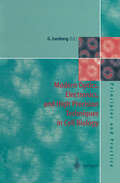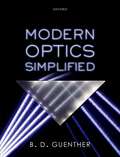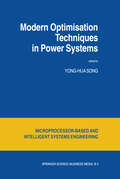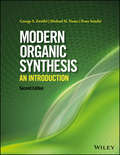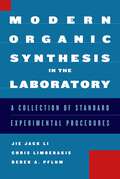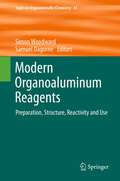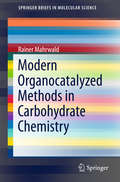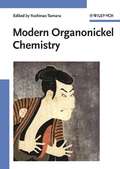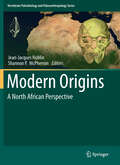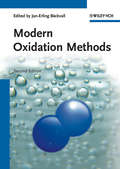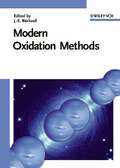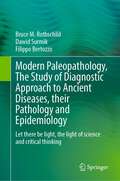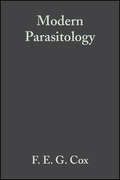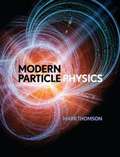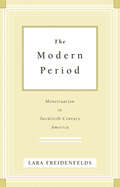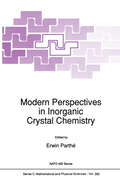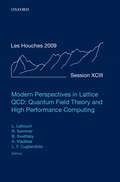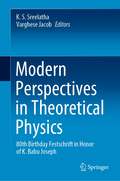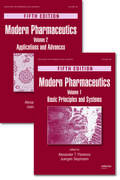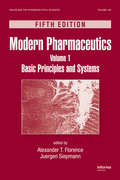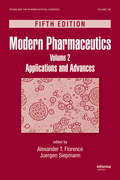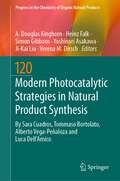- Table View
- List View
Modern Optics, Electronics and High Precision Techniques in Cell Biology (Principles and Practice)
by Gerhard IsenbergIn spite of tremendous scientific progress over the past years, cell biologists do not yet understand the fundamental processes that determine the life cy cle of a cell. Such are: cell movement and cell spreading, cell division, cell communication, cell signaling, cell regeneration and cell death. Biochemistry has enabled us to recognize and to isolate an overwhelming number of new proteins. In vitro assays and the reinjection of proteins into cells and tissues have provided insights into molecular functions and cellular mechanisms. The renaissance of the genetic approach by applying restriction enzymes and vectors, PCR and antisense technology has enabled us to overexpress certain cellular products, to make altered constructs of cell components or to create "knock-out" mutants that entirely lack the factor of interest. Amazingly en ough, all these molecular toys have led to a stream of information but not, in a comparable degree, to a better understanding. Has the puzzle become too complex to get solved; or are the windows too small that we are looking through? As an attempt to answer both questions, the aim of the present mono graph Modern Optics, Electronics and High Precision Techniques in Cell Biol ogy is first to provide cell and molecular biologists with a whole new scope of easily applicable techniques including brand-new optical, biophysical, physicochemical and biosensoric devices. Secondly, these newly developed techniques allow us to look at cells and biological systems as a whole.
Modern Optics Simplified
by B. D. GuentherThis textbook reduces the complexity of the coverage of optics to allow a student with only elementary calculus to learn the principles of optics and the modern Fourier theory of diffraction and imaging. Students majoring in sciences or engineering and taking a standard physics course on optics will find this text useful. Examples of a variety of applications dependent on optics allow the student to connect this course to their particular field of interest. Topics covered include aberrations with experimental examples, correction of chromatic aberration, explanation of coherence and the use of interference theory to design an antireflection coating. Fourier transform optics and its application to diffraction and imaging, use of Gaussian wave theory, and fiber optics make the text of interest to those in electrical and bioengineering as well as physics and medical science. The text includes hundreds of photos, figures and diagrams to provide readers with strong visual insights into optics. More difficult, optional topics are highlighted throughout, and the need for experience with differential equations and extensive use of vector theory are avoided by using a one dimensional theory where possible. Maxwell's equations are introduced only to determine the properties of a light wave, and the boundary conditions are introduced to characterize reflection and refraction. Most discussion is limited to reflection. The book also introduces Fourier transforms as they are needed in the discussion of diffraction and imaging.
Modern Optimisation Techniques in Power Systems (Intelligent Systems, Control and Automation: Science and Engineering #20)
by Yong-Hua Yong-Hua SongThe electric power industry is currently undergoing an unprecedented reform. The deregulation of electricity supply industry has introduced new opportunity for competition to reduce the cost and cut the price. It is a tremendous challenge for utilities to maintain an economical and reliable supply of electricity in such an environment. Faced by an increasingly complicated existence, power utilities need efficient tools and aids to ensure that electrical energy of the desired quality can be provided at the lowest cost. The overall objective, both for short-term and long-term operations, is then to find the best compromise between the requirements of security and economy. That is, effective tools are urgently required to solve highly constrained optimisation problems. In recent years, several major modem optimisation techniques have been applied to power systems. A large number of papers and reports have been published. In this respect, it is timely to edit a book on this topic with an aim to report the state of the art development internationally in this area.
Modern Organic Synthesis: An Introduction
by George S. Zweifel Michael H. Nantz Peter SomfaiThis book bridges the gap between sophomore and advanced / graduate level organic chemistry courses, providing students with a necessary background to begin research in either an industry or academic environment. • Covers key concepts that include retrosynthesis, conformational analysis, and functional group transformations as well as presents the latest developments in organometallic chemistry and C–C bond formation• Uses a concise and easy-to-read style, with many illustrated examples• Updates material, examples, and references from the first edition• Adds coverage of organocatalysts and organometallic reagents
Modern Organic Synthesis: An Introduction
by George S. Zweifel Michael H. Nantz Peter SomfaiThis book bridges the gap between sophomore and advanced / graduate level organic chemistry courses, providing students with a necessary background to begin research in either an industry or academic environment. • Covers key concepts that include retrosynthesis, conformational analysis, and functional group transformations as well as presents the latest developments in organometallic chemistry and C–C bond formation• Uses a concise and easy-to-read style, with many illustrated examples• Updates material, examples, and references from the first edition• Adds coverage of organocatalysts and organometallic reagents
Modern Organic Synthesis in the Laboratory
by Jie Jack Li Chris Limberakis Derek A. PflumSearching for reaction in organic synthesis has been made much easier in the current age of computer databases. However, the dilemma now is which procedure one selects among the ocean of choices. Especially for novices in the laboratory, it becomes a daunting task to decide what reaction conditions to experiment with first in order to have the best chance of success. This collection intends to serve as an "older and wiser lab-mate" one could have by compiling many of the most commonly used experimental procedures in organic synthesis. With chapters that cover such topics as functional group manipulations, oxidation, reduction, and carbon-carbon bond formation, Modern Organic Synthesis in the Laboratory will be useful for both graduate students and professors in organic chemistry and medicinal chemists in the pharmaceutical and agrochemical industries.
Modern Organic Synthesis in the Laboratory
by Jie Jack Li Chris Limberakis Derek A. PflumSearching for reaction in organic synthesis has been made much easier in the current age of computer databases. However, the dilemma now is which procedure one selects among the ocean of choices. Especially for novices in the laboratory, it becomes a daunting task to decide what reaction conditions to experiment with first in order to have the best chance of success. This collection intends to serve as an "older and wiser lab-mate" one could have by compiling many of the most commonly used experimental procedures in organic synthesis. With chapters that cover such topics as functional group manipulations, oxidation, reduction, and carbon-carbon bond formation, Modern Organic Synthesis in the Laboratory will be useful for both graduate students and professors in organic chemistry and medicinal chemists in the pharmaceutical and agrochemical industries.
Modern Organoaluminum Reagents: Preparation, Structure, Reactivity and Use (Topics in Organometallic Chemistry #41)
by Simon Woodward and Samuel DagorneJanusz Lewiński and Andrew E. H. Wheatley: Simple trivalent organoaluminum species: perspectives on structure, bonding and reactivity.- Stephan Schulz: Organoaluminum complexes with bonds to s-block, p-block, d-block, and f-block metal centers.- Samuel Dagorne and Christophe Fliedel: Low valent organoaluminium (+I, +II) species.- Rudolf Wehmschulte: Organoaluminum species in homogeneous polymerization catalysis.- Paul Knochel, Tobias Blümke, Klaus Groll and Yi-Hung Chen: Preparation of Organoalanes for Organic Synthesis.- Yuki Naganawa and Keiji Maruoka: Reactions Triggered by Lewis Acidic Organoaluminum Species.- Usein M. Dzhemilev and Vladimir A. D'yakonov: Hydro-, Carbo- and Cycloalumination of Unsaturated Compounds.- Andreas Kolb and Paultheo von Zezschwitz: Organoaluminum Couplings to Carbonyls, Imines and Halides.- Oscar Pàmies and Montserrat Diéguez: Conjugate Addition of Organoaluminum Species to Michael Acceptors and Related Processes.
Modern Organocatalyzed Methods in Carbohydrate Chemistry (SpringerBriefs in Molecular Science)
by Rainer MahrwaldThis brief presents a valuable and concise overview of organocatalytic methodologies in carbohydrate chemistry. It includes glycosylation processes with de novo syntheses of carbohydrates and chain elongation of carbohydrates. The author, an academic of international distinction, goes on to make comparisons between traditional organic and metalorganic transformations.
Modern Organonickel Chemistry
by Yoshinao TamaruOrganonickel chemistry plays an increasingly important role in organic chemistry, and interest in this topic is now just as keen as in organopalladium chemistry. While there are numerous, very successful books on the latter, a book specializing in organonickel chemistry is long overdue. Edited by one of the leading experts in the field, this volume covers the many discoveries made over the past 30 years, and previously scattered throughout the literature. Active researchers working at the forefront of organonickel chemistry provide a comprehensive review of the topic, including cross-coupling reactions, asymmetric synthesis and heterogeneous catalysis reaction types. A must-have for both organometallic chemists and synthetic organic chemists.
Modern Origins: A North African Perspective (Vertebrate Paleobiology and Paleoanthropology)
by Jean-Jacques Hublin and Shannon P. McPherronOver the last decade, Africa has taken a central position in the search for the timing and mechanisms leading to modern human origins, and the rich archaeological and human paleontological record of North Africa is critical to this search. In this volume, we bring together new research into the archaeology, human paleontology, chronology, and environmental context of modern human origins in North Africa. The result is a volume that better integrates the North African record into the modern human origins debate and at the same time highlights the research questions that are currently the focus of continued work in the area.
Modern Oxidation Methods
by Jan–Erling BäckvallWhile rust is an unwanted oxidation reaction, there are also many other useful oxidation reactions that are extremely important and number among the most commonly used reactions in the chemical industry. This completely revised, updated second edition now includes additional sections on industrial oxidation and biochemical oxidation. Edited by one of the world leaders in the field, high-quality contributions cover every important aspect from classical to green chemistry methods: - Recent Developments in Metal-catalyzed Dihydroxylation of Alkenes - Transition Metal-Catalyzed Epoxidation of Alkenes - Organocatalytic Oxidation. Ketone-Catalyzed Asymmetric Epoxidation of Alkenes and Synthetic Applications - Catalytic Oxidations with Hydrogen Peroxide in Fluorinated Alcohol Solvents - Modern Oxidation of Alcohols using Environmentally Benign Oxidants - Aerobic Oxidations and Related Reactions Catalyzed by N-Hydro xyphthalimide - Ruthenium-Catalyzed Oxidation for Organic Synthesis - Selective Oxidation of Amines and Sulfides - Liquid Phase Oxidation Reactions Catalyzed by Polyoxometalates - Oxidation of Carbonyl Compounds - Manganese-Catalyzed Oxidation with Hydrogen Peroxide - Biooxidation with Cytochrome P450 Monooxygenases By providing an overview of this vast topic, the book represents an unparalleled aid for organic, catalytic and biochemists working in the field.
Modern Oxidation Methods
by Jan-Erling BäckvallAt the very latest, with the award of the 2001 Nobel Prize for work on asymmetric oxidation, there has been a need for a comprehensive book on such methods. Edited by J.-E. Backvall, one of the world's leaders in the field, this book fills that gap by covering the topic, from classical to green chemistry methods. He has put together a plethora of well-established authors from all over the world who cover every important aspect in high-quality contributions -- whether aerobic oxidation or transition metal-catalyzed epoxidation of alkenes. By providing an overview of this huge topic, this book represents an unparalleled aid for any chemist working in the field. Chapters include: Recent Developments in the Osmium-Catalyzed Dihydroxylation of Olefins Transition Metal-Catalyzed Epoxidation of Alkenes Organocatalytic Oxidation - Ketone-Catalyzed Asymmetric Epoxidation of Olefins Modern Oxidation of Alcohols using environmentally Benign Oxidants Aerobic Oxidations and Related Reactions Catalyzed by N-Hydroxyphthalimide Ruthenium-Catalyzed Oxidation of Alkenes, Alcohols, Amines, Amides, b-Lactams, Phenols, and Hydrocarbons Selective Oxidations of Sulfides and Amines Liquid Phase Oxidation Reactions Catalyzed by Polyoxometalates Oxidation of Carbonyl Compounds Mn-catalysed Oxidation with Hydrogen Peroxide
Modern Oxidation Methods
by Jan-Erling B CkvallWhile rust is an unwanted oxidation reaction, there are also many other useful oxidation reactions that are extremely important and number among the most commonly used reactions in the chemical industry. This completely revised, updated second edition now includes additional sections on industrial oxidation and biochemical oxidation. Edited by one of the world leaders in the field, high-quality contributions cover every important aspect from classical to green chemistry methods: - Recent Developments in Metal-catalyzed Dihydroxylation of Alkenes - Transition Metal-Catalyzed Epoxidation of Alkenes - Organocatalytic Oxidation. Ketone-Catalyzed Asymmetric Epoxidation of Alkenes and Synthetic Applications - Catalytic Oxidations with Hydrogen Peroxide in Fluorinated Alcohol Solvents - Modern Oxidation of Alcohols using Environmentally Benign Oxidants - Aerobic Oxidations and Related Reactions Catalyzed by N-Hydro xyphthalimide - Ruthenium-Catalyzed Oxidation for Organic Synthesis - Selective Oxidation of Amines and Sulfides - Liquid Phase Oxidation Reactions Catalyzed by Polyoxometalates - Oxidation of Carbonyl Compounds - Manganese-Catalyzed Oxidation with Hydrogen Peroxide - Biooxidation with Cytochrome P450 Monooxygenases By providing an overview of this vast topic, the book represents an unparalleled aid for organic, catalytic and biochemists working in the field.
Modern Paleopathology, The Study of Diagnostic Approach to Ancient Diseases, their Pathology and Epidemiology: Let there be light, the light of science and critical thinking
by Bruce M. Rothschild Dawid Surmik Filippo BertozzoThe study of paleopathology has two very different constituencies, the medical scientist and the zoologist/paleontologist/anthropologist. Their investigative procedures and professional jargon are different, sometimes to the point of mutual incomprehensibility. Paleontologists/anthropologists/zoologists have a limited data base for the characterization and interpretation of pathology. This must come from the human and veterinary medical experience.What, beyond intellectual satisfaction, can the health care community expect from this relationship? The past history of the appearance and dispersal of infectious disease and cancer is of considerable theoretical importance and leads to new insights on the nature and transmission of diseases that are otherwise ambiguous. The discovery of rheumatoid arthritis in pre-Columbian North America exemplifies insights gained.The current effort delineates osseous impact of disease (as manifest in clinical populations diagnosed in life), representation in the zoologic, paleontologic and anthropologic record, and assessment techniques that can be confidently applied. The chapters form “columns” that provide the foundation for scientific critical thinking. The actual integration of the information is in its application. Our purpose is to provide a data base and atlas of actually documented skeletal impact of diseases (as population phenomenon), an initial data base of reported skeletal pathology, and a methodology for expanding this to new arenas.The first section of the book examines the scientific basis of paleopathology, its transition from speculation-based musings, resolution of misconceptions and the denouement of paleo-epidemiology. The second section provides holistic analysis of the gamut of pathology/diseases with significant skeletal impact, with a validated archeologic/zoological/paleontological record. The third section provides a glossary to resolve the semantic challenges inherent to interdisciplinary efforts. The fourth section provides an atlas of pathology representation in the fossil record. Ultimately, this book intends to present a scientifically-validated approach to recognition of disease in the archeological, zoological and paleontological record, superseding previous speculation-based offerings.
Modern Parasitology: A Textbook of Parasitology
by F. E. G. CoxThis is a thorough revision and update of the highly successful first edition, which which achieved sales in excess of 4,500. The text serves as a comprehensive introduction to parasitology for both undergraduate and beginning graduate students. In this edition, particular emphasis is placed on parasites of human and veterinary importance. The first three chapters in the text are concerned with how parasites 'work,' their biochemistry, molecular and cell biology and physiology. The remaining chapters cover ecology and epidemiology, immunology and chemotherapy, with the final chapter covering integrated control. This new edition contains new material on cell and molecular biology, vectors and control, which is in contrast to the general biological approach of the first edition. The second edition will succeed the first as the major text on parasitology for students in biology, zoology, microbiology, medicine, veterinary medicine, tropical medicine and public health.
Modern Particle Physics (PDF)
by Mark ThomsonUnique in its coverage of all aspects of modern particle physics, this textbook provides a clear connection between the theory and recent experimental results, including the discovery of the Higgs boson at CERN. It provides a comprehensive and self-contained description of the Standard Model of particle physics suitable for upper-level undergraduate students and graduate students studying experimental particle physics. Physical theory is introduced in a straightforward manner with full mathematical derivations throughout. Fully-worked examples enable students to link the mathematical theory to results from modern particle physics experiments. End-of-chapter exercises, graded by difficulty, provide students with a deeper understanding of the subject. Online resources available at www.cambridge.org/MPP feature password-protected fully-worked solutions to problems for instructors, numerical solutions and hints to the problems for students and PowerPoint slides and JPEGs of figures from the book.
The Modern Period: Menstruation in Twentieth-Century America
by Lara FreidenfeldsThe Modern Period examines how and why Americans adopted radically new methods of managing and thinking about menstruation during the twentieth century. In the early twentieth century women typically used homemade cloth "diapers" to absorb menstrual blood, avoided chills during their periods to protect their health, and counted themselves lucky if they knew something about menstruation before menarche. New expectations at school, at play, and in the workplace, however, made these menstrual traditions problematic, and middle-class women quickly sought new information and products that would make their monthly periods less disruptive to everyday life.Lara Freidenfelds traces this cultural shift, showing how Americans reframed their thinking about menstruation. She explains how women and men collaborated with sex educators, menstrual product manufacturers, advertisers, physical education teachers, and doctors to create a modern understanding of menstruation. Excerpts from seventy-five interviews—accounts by turns funny and moving—help readers to identify with the experiences of the ordinary people who engineered these changes. The Modern Period ties historical changes in menstrual practices to a much broader argument about American popular modernity in the twentieth century. Freidenfelds explores what it meant to be modern and middle class and how those ideals were reflected in the menstrual practices and beliefs of the time. This accessible study sheds new light on the history of popular modernity, the rise of the middle class, and the relationship of these phenomena to how Americans have cared for and managed their bodies.
Modern Perspectives in Inorganic Crystal Chemistry (Nato Science Series C: #382)
by Erwin ParthéThe study of crystal structures has had an ever increasing impact on many fields of science such as physics, chemistry, biology, materials science, medicine, pharmacy, metallurgy, mineralogy and geology. Particularly, with the advent of direct methods of structure determination, the data on crystal structures are accumulating at an unbelievable pace and it becomes more and more difficult to oversee this wealth of data. A crude rationalization of the structures of organic compounds and the atom coordinations can be made with the well-known Kekule model, however, no such generally applicable model exists for the structures of inorganiC and particularly intermetallic compounds. There is a need to rationalize the inorganic crystal structures, to find better ways of describing them, of denoting the geometrical relationships between them, of elucidating the electronic factors and of explaining the bonding between the atoms with the aim of not only having a better understanding of the known structures, but also of predicting structural features of new compounds.
Modern Perspectives in Lattice QCD: Lecture Notes of the Les Houches Summer School: Volume 93, August 2009 (Lecture Notes of the Les Houches Summer School)
The book is based on the lectures delivered at the XCIII Session of the École de Physique des Houches, held in August, 2009. The aim of the event was to familiarize the new generation of PhD students and postdoctoral fellows with the principles and methods of modern lattice field theory, which aims to resolve fundamental, non-perturbative questions about QCD without uncontrolled approximations. The emphasis of the book is on the theoretical developments that have shaped the field in the last two decades and that have turned lattice gauge theory into a robust approach to the determination of low energy hadronic quantities and of fundamental parameters of the Standard Model. By way of introduction, the lectures begin by covering lattice theory basics, lattice renormalization and improvement, and the many faces of chirality. A later course introduces QCD at finite temperature and density. A broad view of lattice computation from the basics to recent developments was offered in a corresponding course. Extrapolations to physical quark masses and a framework for the parameterization of the low-energy physics by means of effective coupling constants is covered in a lecture on chiral perturbation theory. Heavy-quark effective theories, an essential tool for performing the relevant lattice calculations, is covered from its basics to recent advances. A number of shorter courses round out the book and broaden its purview. These included recent applications to the nucleon—nucleon interation and a course on physics beyond the Standard Model.
Modern Perspectives in Theoretical Physics: 80th Birthday Festschrift in Honor of K. Babu Joseph
by K. S. Sreelatha Varghese JacobThis book highlights the review of articles in theoretical physics by the students of Professor K. Babu Joseph, as a Festschrift for his 80th Birthday. This book is divided into four sections based on the contributions of Babu Joseph and his students. The four sections are Cosmology, High Energy Physics, Mathematical Physics and Non-linear Dynamics and its applications.
Modern Pharmaceutics, Two Volume Set
by Alexander T. Florence Juergen SiepmannThis new edition brings you up-to-date on the role of pharmaceutics and its future paradigms in the design of medicines. Contributions from over 30 international thought leaders cover the core disciplines of pharmaceutics and the impact of biotechnology, gene therapy, and cell therapy on current findings. Modern Pharmaceutics helps you stay current
Modern Pharmaceutics Volume 1: Basic Principles and Systems, Fifth Edition
by Alexander T. Florence Juergen SiepmannWith over 100 illustrations, Volume 1 addresses the core disciplines of pharmaceutics (absorption, PK, excipients, tablet dosage forms, and packaging), and explores the challenges and paradigms of pharmaceutics.Key topics in Volume 1 include: principles of drug absorption, chemical kinetics, and drug stability pharmacokinetics the effect of rout
Modern Pharmaceutics, Volume 2: Applications and Advances, Fifth Edition
by Alexander T. Florence Juergen SiepmannVolume 2 addresses the applications and approaches in advanced drug delivery systems, including transdermal, pulmonary, and ocular routes. In addition, this text discusses the impact of the shift to personalized medicines in the fields of pharmaceutical biotechnology, pharmacogenomics, and nanotechnology.Volume 2 investigates: sustained- and contr
Modern Photocatalytic Strategies in Natural Product Synthesis (Progress in the Chemistry of Organic Natural Products #120)
by A. Douglas Kinghorn Heinz Falk Simon Gibbons Yoshinori Asakawa Ji-Kai Liu Verena M. DirschThis book presents recent reports of total syntheses involving a photocatalytic reaction as a key step in the methodology. Modern photocatalysis has proven its generality for the development and functionalization of native functionalities. To date, the field has found broad applications in diverse research areas, including the total synthesis of natural products. Among the selected examples presented in this book, it highlights how the photocatalytic process proceeds in a highly chemo-, regio-, and stereoselective manner, thereby allowing the rapid access to structurally complex architectures under light-driven conditions.
